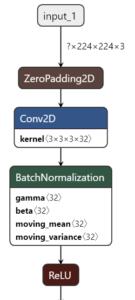Neural networks, and especially the deep ones, have achieved many state-of-the-art results over the past few years. Many scholars and practitioners have used them to create cool tools and new techniques, which are used in various real-world scenarios today.
Let's say that you've identified a new type of architecture that works really well. Now, you wish to communicate about this architecture. How do you do so? And how can you visualize your neural network architecture easily - or inspect it, if you will?
Netron is such a tool. Being a viewer for neural networks and machine learning models, it generates beautiful visualizations that you can use to clearly communicate the structure of your neural network. What's more, using the tool, you can explore your models in great detail. And best of all, it's a cross-platform tool - which also means Windows and Mac support - and works with a wide range of machine learning frameworks and model formats.
In this blog post, we'll take a look at Netron. First, we'll discuss what it is and what frameworks and model formats it supports. Then, we move on to an example with Keras: we show you how to generate a Netron-ready model output, and how to visualize and inspect it subsequently.
Let's take a look! :)
Introducing Netron

Let's now take a look at Netron. Created by Lutz Roeder - from now on cited as Roeder (2020) - is a cross-platform tool for visualizing deep learning models, specifically deep neural networks.
Or as they describe their tool: Netron is a viewer for neural network, deep learning and machine learning models (Roeder, 2020).
It can generate beautiful visualizations of your neural network and supports a wide range of frameworks and formats. A slice from such a visualization can be seen on the right, and was generated from a Keras model.
Let's now take a look at the frameworks and formats that are supported by Netron. Then, we'll show you how to install the tool - which is really easy, and given the fact that it's cross-platform, it's supported for Windows and Mac machines as well.
Then, we continue by providing an example for Keras.
What frameworks and formats does Netron support?
As you can see, Netron supports a wide range of frameworks - and offers experimental support for a wide range of others (Roeder, 2020) :)
| Framework | Supported? | File types | |

Hi, I'm Chris!
I know a thing or two about AI and machine learning. Welcome to MachineCurve.com, where machine learning is explained in gentle terms.
Getting started
Foundation models
Learn how large language models and other foundation models are working and how you can train open source ones yourself.
Keras
Keras is a high-level API for TensorFlow. It is one of the most popular deep learning frameworks.
Machine learning theory
Read about the fundamentals of machine learning, deep learning and artificial intelligence.
Most recent articles
January 2, 2024
What is Retrieval-Augmented Generation?
December 27, 2023
In-Context Learning: what it is and how it works
December 22, 2023
CLIP: how it works, how it's trained and how to use it
Article tags
Most popular articles
February 18, 2020
How to use K-fold Cross Validation with TensorFlow 2 and Keras?
December 28, 2020
Introduction to Transformers in Machine Learning
December 27, 2021
StyleGAN, a step-by-step introduction
July 17, 2019
This Person Does Not Exist - how does it work?
October 26, 2020
Your First Machine Learning Project with TensorFlow 2.0 and Keras
Connect on social media
Connect with me on LinkedIn
To get in touch with me, please connect with me on LinkedIn. Make sure to write me a message saying hi!
Side info
The content on this website is written for educational purposes. In writing the articles, I have attempted to be as correct and precise as possible. Should you find any errors, please let me know by creating an issue or pull request in this GitHub repository.
All text on this website written by me is copyrighted and may not be used without prior permission. Creating citations using content from this website is allowed if a reference is added, including an URL reference to the referenced article.
If you have any questions or remarks, feel free to get in touch.
TensorFlow, the TensorFlow logo and any related marks are trademarks of Google Inc.
PyTorch, the PyTorch logo and any related marks are trademarks of The Linux Foundation.
Montserrat and Source Sans are fonts licensed under the SIL Open Font License version 1.1.
Mathjax is licensed under the Apache License, Version 2.0.